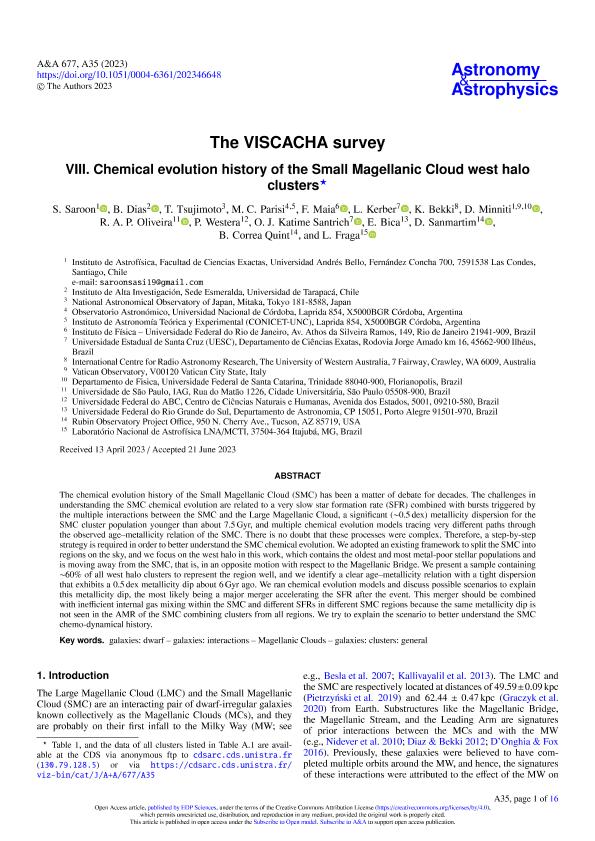Artículo
The VISCACHA survey. VIII. Chemical evolution history of the Small Magellanic Cloud west halo clusters
Saroon, S.; Dias, B.; Tsujimoto, T.; Parisi, Maria Celeste ; Maia, F.; Kerber, L.; Bekki, K.; Minniti, D.; Oliveira, R. A. P.; Westera, P.; Katime Santrich, O. J.; Bica, E.; Sanmartim, D.; Correa Quint, B.; Fraga, L.
; Maia, F.; Kerber, L.; Bekki, K.; Minniti, D.; Oliveira, R. A. P.; Westera, P.; Katime Santrich, O. J.; Bica, E.; Sanmartim, D.; Correa Quint, B.; Fraga, L.
 ; Maia, F.; Kerber, L.; Bekki, K.; Minniti, D.; Oliveira, R. A. P.; Westera, P.; Katime Santrich, O. J.; Bica, E.; Sanmartim, D.; Correa Quint, B.; Fraga, L.
; Maia, F.; Kerber, L.; Bekki, K.; Minniti, D.; Oliveira, R. A. P.; Westera, P.; Katime Santrich, O. J.; Bica, E.; Sanmartim, D.; Correa Quint, B.; Fraga, L.
Fecha de publicación:
09/2023
Editorial:
EDP Sciences
Revista:
Astronomy and Astrophysics
ISSN:
1432-0746
Idioma:
Inglés
Tipo de recurso:
Artículo publicado
Clasificación temática:
Resumen
The chemical evolution history of the Small Magellanic Cloud (SMC) has been a matter of debate for decades. The challenges in understanding the SMC chemical evolution are related to a very slow star formation rate (SFR) combined with bursts triggered by the multiple interactions between the SMC and the Large Magellanic Cloud, a significant (∼0.5 dex) metallicity dispersion for the SMC cluster population younger than about 7.5 Gyr, and multiple chemical evolution models tracing very different paths through the observed age–metallicity relation of the SMC. There is no doubt that these processes were complex. Therefore, a step-by-step strategy is required in order to better understand the SMC chemical evolution. We adopted an existing framework to split the SMC intoregions on the sky, and we focus on the west halo in this work, which contains the oldest and most metal-poor stellar populations and is moving away from the SMC, that is, in an opposite motion with respect to the Magellanic Bridge. We present a sample containing ∼60% of all west halo clusters to represent the region well, and we identify a clear age–metallicity relation with a tight dispersionthat exhibits a 0.5 dex metallicity dip about 6 Gyr ago. We ran chemical evolution models and discuss possible scenarios to explain this metallicity dip, the most likely being a major merger accelerating the SFR after the event. This merger should be combined with inefficient internal gas mixing within the SMC and different SFRs in different SMC regions because the same metallicity dip is not seen in the AMR of the SMC combining clusters from all regions. We try to explain the scenario to better understand the SMC chemo-dynamical history.
Archivos asociados
Licencia
Identificadores
Colecciones
Articulos(IATE)
Articulos de INST.DE ASTRONOMIA TEORICA Y EXPERIMENTAL
Articulos de INST.DE ASTRONOMIA TEORICA Y EXPERIMENTAL
Citación
Saroon, S.; Dias, B.; Tsujimoto, T.; Parisi, Maria Celeste; Maia, F.; et al.; The VISCACHA survey. VIII. Chemical evolution history of the Small Magellanic Cloud west halo clusters; EDP Sciences; Astronomy and Astrophysics; 677; 9-2023
Compartir
Altmétricas



